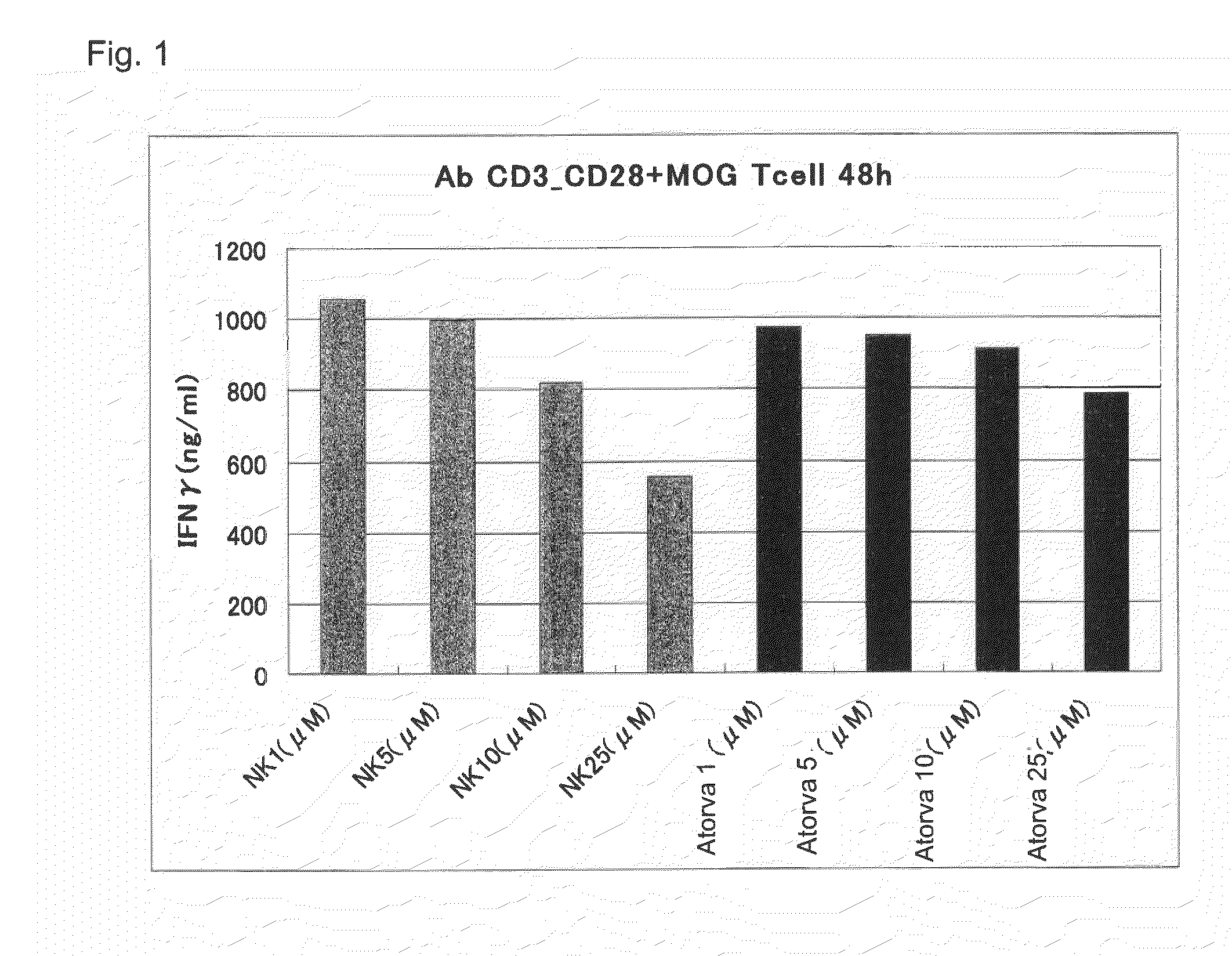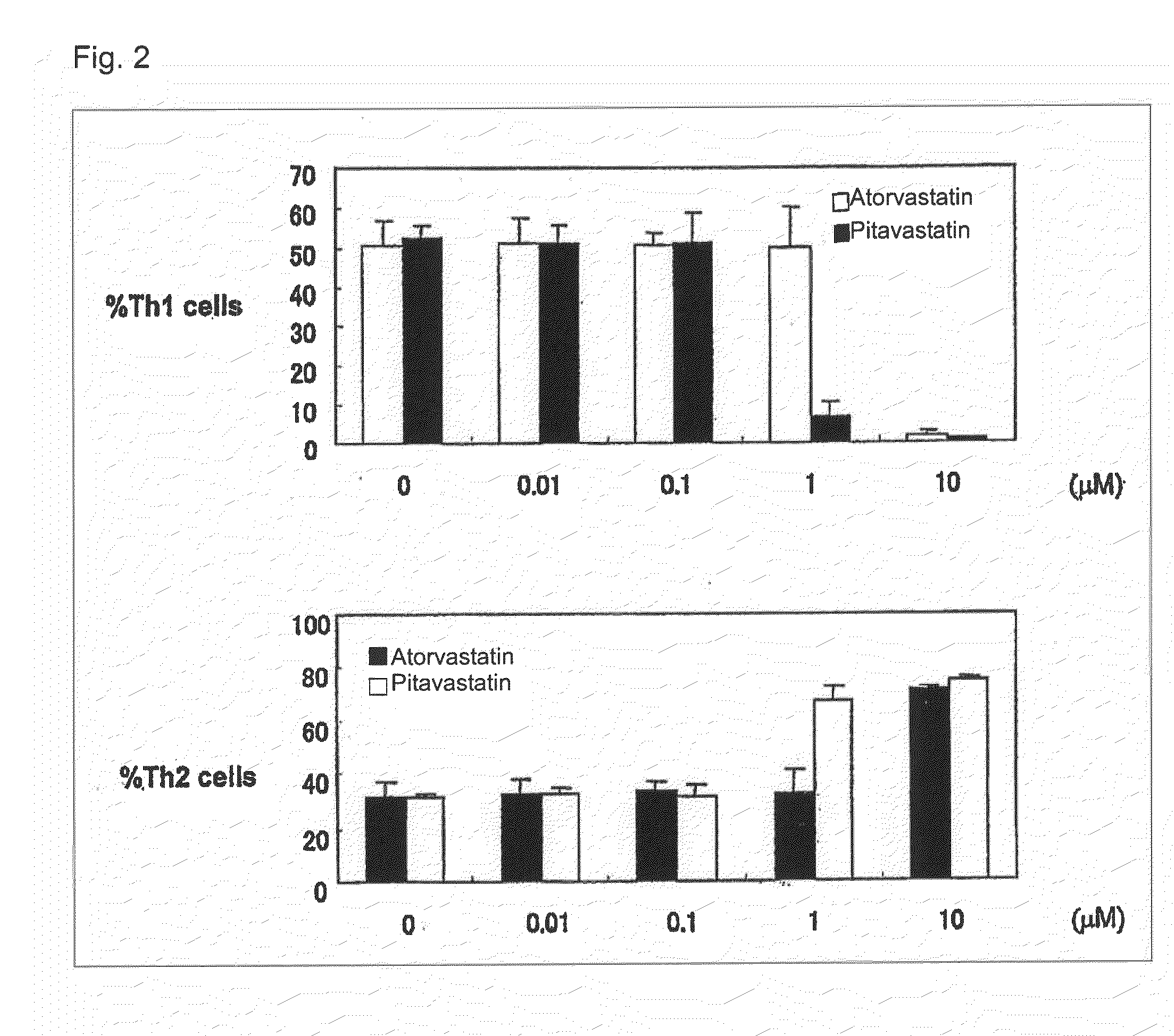Inhibitor of the differentiation of t cells into th1 cells
a technology of t cell and inhibitor, which is applied in the direction of drug composition, biocide, metabolic disorder, etc., can solve the problems of imposing a considerable burden on patients in terms of complian
- Summary
- Abstract
- Description
- Claims
- Application Information
AI Technical Summary
Benefits of technology
Problems solved by technology
Method used
Image
Examples
example 1
(Method)
[0035]Five C57BL / 6 mice were immunized with myelin oligodendrocyte glycoprotein (MOG), and mice with experimental autoimmune encephalomyelitis (EAE) (i.e., a model of multiple sclerosis) were prepared in a conventional manner. On day 14 after immunization, spleen cells were collected from each mouse and cultured in a 24-well culture plate coated with CD3 and CD28 antibodies, and then stimulated with MOG in the presence of pitavastatin or atorvastatin, to thereby activate Th1 cells. The Th1 cytokine (IFN-γ) concentration of the supernatant of the resultant cell culture was determined through ELISA.
(Results)
[0036]As shown in FIG. 1, a concentration of 10 μM or more of pitavastatin (“NK” in FIG. 1) significantly reduced the amount of IFN-γ produced by Th1 cells derived from spleen cells of MOG-immunized mice; i.e., inhibited activation of Th1 cells. As also shown in FIG. 1, 25 μM of atorvastatin (“Atorva” in FIG. 1) significantly inhibited production of INF-γ by Th1 cells.
example 2
(Method)
[0037]Peripheral blood (10 mL) was collected from six healthy adults in heparin, and monocytes were isolated through the Ficol-Hypaque method (i.e., a customary method). The thus-isolated cells were diluted to 1×106 / mL and then inoculated into a 24-well culture plate coated with CD3 and CD28 antibodies (Falcon), followed by culturing for four days in the presence of IL-12 (100 ng / mL), to thereby induce differentiation of T cells into Th1 cells. Atorvastatin or pitavastatin (0.01 to 10 μM) was added at the time of initiation of culturing, and the effect of each drug on differentiation of T cells into Th1 cells was examined. After completion of culturing, cells were washed thrice with PBS, and cytokines (IFN-γ and IL-4) in the cells and CD4 on the surfaces of the cells were stained in a conventional manner. The ratio of Th1 (CD4-positive, IFN-γ-positive cells) or Th2 (CD4-positive, IL-4-positive cells) to all the CD4-positive T cells was determined through flow cytometry.
[0038...
PUM
| Property | Measurement | Unit |
|---|---|---|
| relapse frequency | aaaaa | aaaaa |
| body weight | aaaaa | aaaaa |
| concentration | aaaaa | aaaaa |
Abstract
Description
Claims
Application Information
 Login to View More
Login to View More - R&D
- Intellectual Property
- Life Sciences
- Materials
- Tech Scout
- Unparalleled Data Quality
- Higher Quality Content
- 60% Fewer Hallucinations
Browse by: Latest US Patents, China's latest patents, Technical Efficacy Thesaurus, Application Domain, Technology Topic, Popular Technical Reports.
© 2025 PatSnap. All rights reserved.Legal|Privacy policy|Modern Slavery Act Transparency Statement|Sitemap|About US| Contact US: help@patsnap.com


